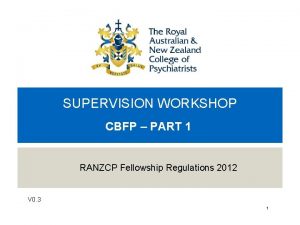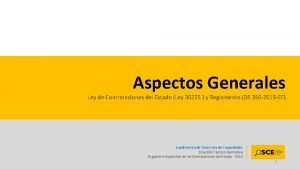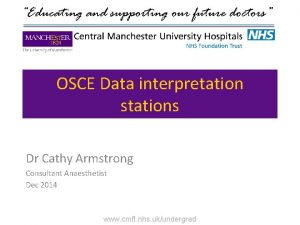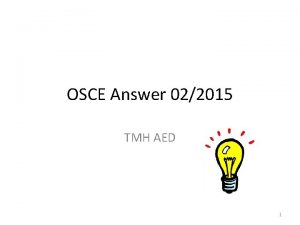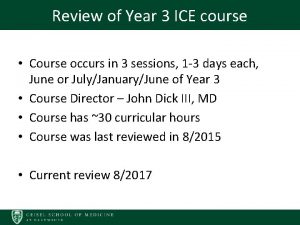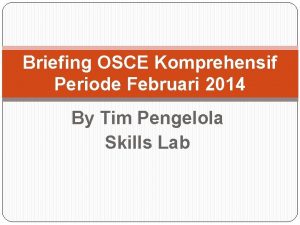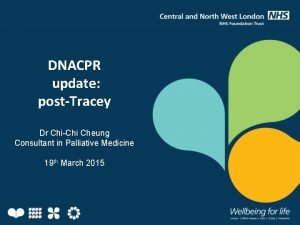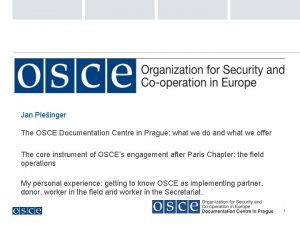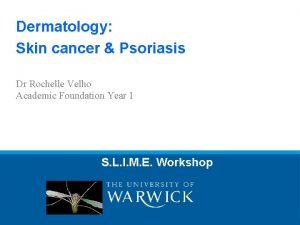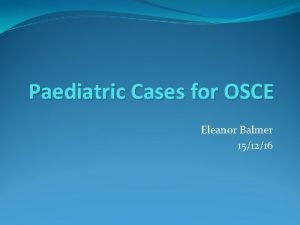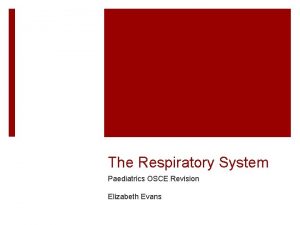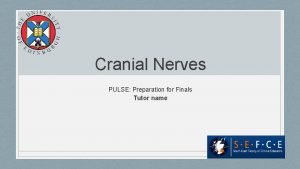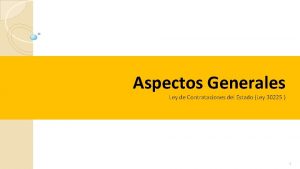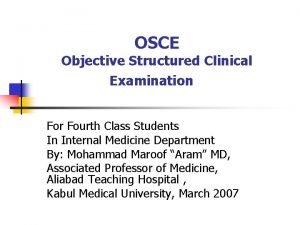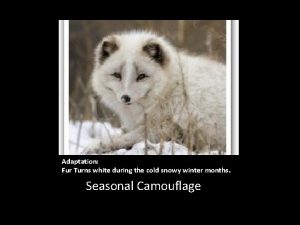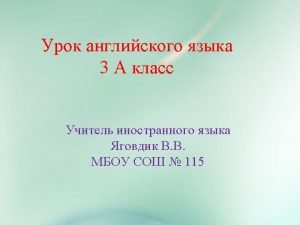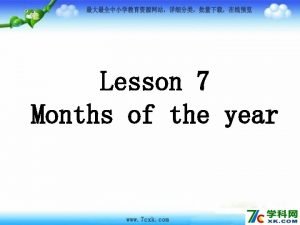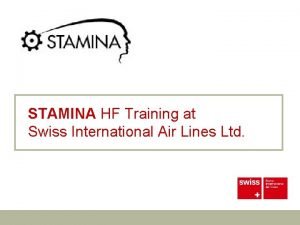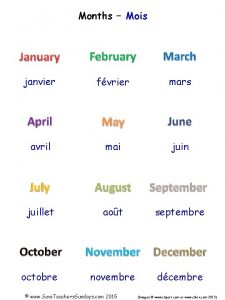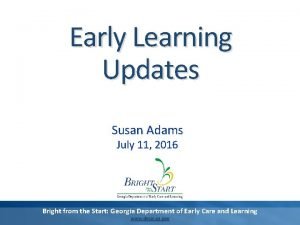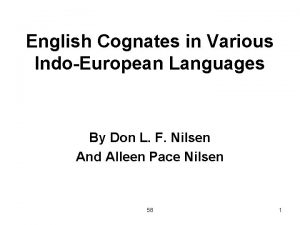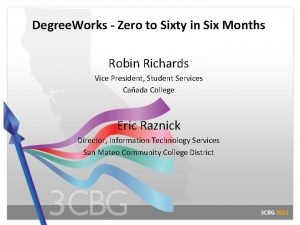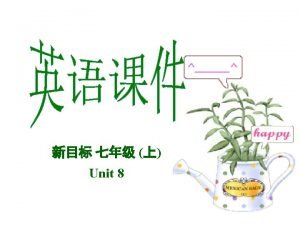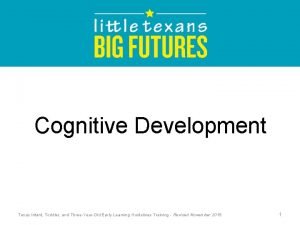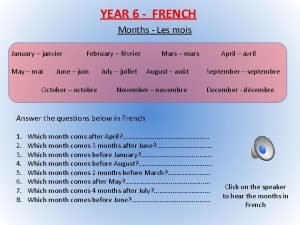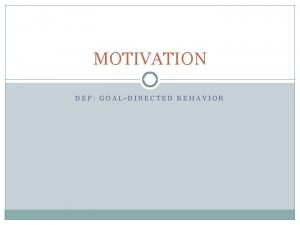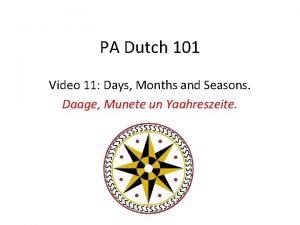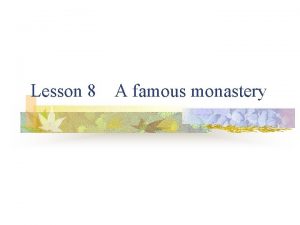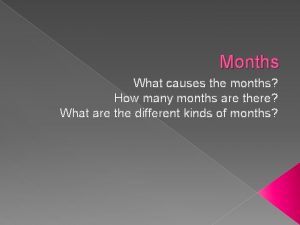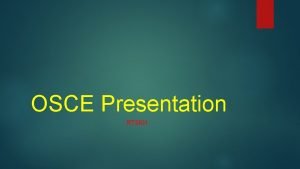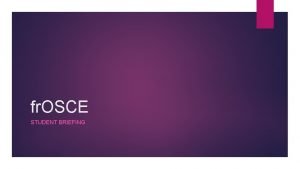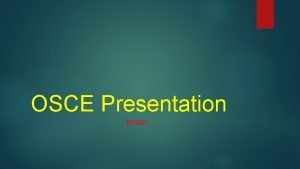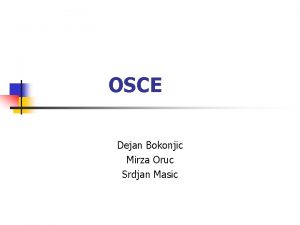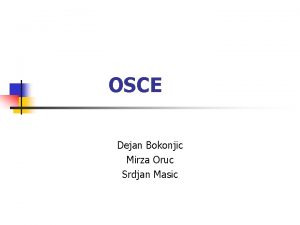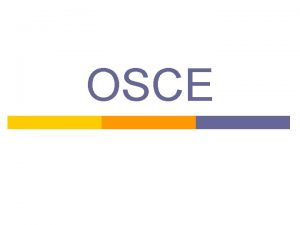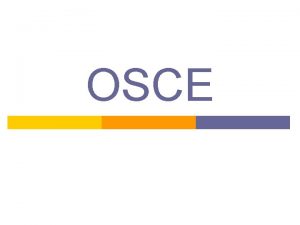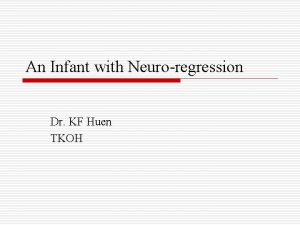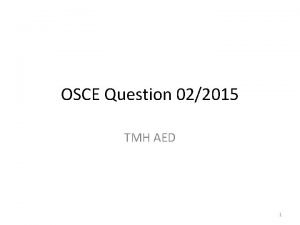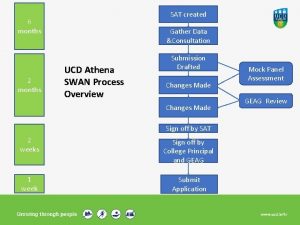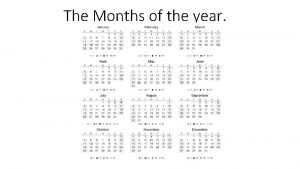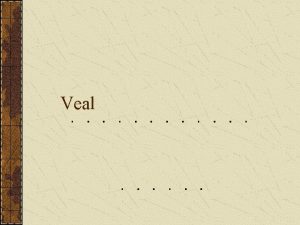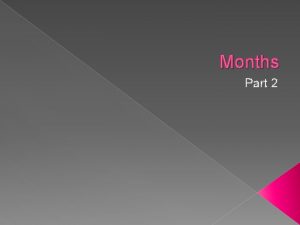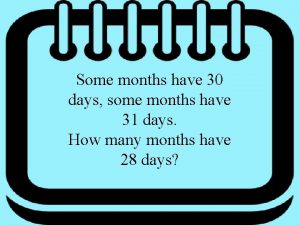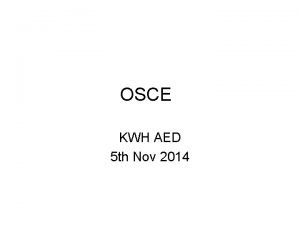OSCE April 2019 TKOH Question 1 7 months













































- Slides: 45

OSCE April 2019 TKOH

Question 1 7 months old baby girl, normal birth history On bottle feeding Brought in by mother, complains of 3 weeks of coughing, rhinorrhea without fever Recent 3 days mother noticed that the baby had SOB , exacerbated by feeding Appetite decreased from 6 oz to 4 oz per feed, similar time to consume a bottle as before. Birth weight 2. 9 kg, now Body weight 6. 5 kg

P/E: Temp 37. 3, HR 107, RR 30 , Sao 2 100% Pink Hydration and peripheral perfusion good No use of accessory muscle, no intercostal insucking Chest clear, bilaterally equal, no added sound


Q 1. What is the CXR finding? Q 2. What are the differential diagnosis?

Q 3. How many types of child abuse are there? Q 4. What are the risk factors for child abuse? Name 4. Q 5. What are the salient history that would suggest element of child abuse? Q 6. Name 4 physical signs highly suggestive of NAI

Q 7. What are the common radiological features of fracture in NAI? (Name 4) Q 8. The mother now refuses admission and wants to go home with the child. What is the best course of action?

Question 2 6 years old autistic boy Referred from GP: torticollis for 5 days Doubtful history of neck sprain by head turning. PE: GC satisfactory, T: 36. 9 C, Neck: torticollis to right side, decreased range of movement Cervical spine mild tenderness, no stepping 4 Limbs spontaneous movement, normal power and reflex

Q 1. Name 4 life-threatening causes of acquired torticollis in children (2 marks) 1

Cervical Spine X ray

Q 2. Describe 2 abnormal X ray findings. (2 marks)

Q 3. Give 2 Differential diagnosis (1 mark)

CT Cervical Spine with Contrast

Q 4. Describe 4 significant CT findings? (2 marks)

Q 5. What is the Diagnosis? (1 mark)

Q 6. How to manage if the boy seems anxious and leaning forward with head in sniffing position ? (2 marks)

Question 3 • 2 years old boy, unremarkable past health, presented with on and off abdominal pain and decreased feeding x 1/7 • Vomited undigested food x 1. • No diarrhea • No blood in stool noted • PE: • • • Lethragic, crying Temp 36. 2 HR 150, RR 20 Abdomen soft, non tender; ? mass felt No hernia

Q 1. Name 3 differential diagnosis

Describe the AXR. What is the diagnosis?

2. What are other possible signs on AXR? She was admitted for Paediatric surgical unit. A bedside USG was done to confirm the diagnosis. 3. What are the possible signs in USG?

4. What is the definitive treatment for stable patients? 5. If the patient also presented with generalized rash, what is the associated condition?

Question 4 A 53 year-old gentleman attended emergency department for palpitation, chest discomfort and dizziness while jogging in a park tonight. PE: - BP 118/101, P 190, Sp. O 2 100% RA - Afebrile - GCS 15/15 - Unremarkable physical exam An ECG was recorded:


1. Is this rhythm supraventricular or ventricular in origin? Give 2 supportive features according to the ECG.

2. What is the diagnosis? List 2 specific diagnostic features on the ECG. 3. List 2 differential diagnoses

5. What is the initial treatment? 6. Despite the initial treatment, the patient becomes very drowsy and BP drops to 67/55 mm. Hg. The rhythm on cardiac monitor is the same. What is your immediate treatment? Please state the dosage as well.

7. Finally the patient is stabilized and transferred to CCU for further observation. What is the definitive management for his condition? (1) • Radiofrequency ablation

Question 5 A 55 -year-old lady with history of asthma and being treated for URI symptoms for 1 week, presents with chest tightness, shortness of breath and a brief syncopal episode which has made her son call the ambulance. Her vital signs are as follows: PE: BP 75/40 P 95, Sp. O 2 85% RA Temperature 35 °C GCS E 4 V 5 M 6, breathless when talking

1. List 2 immediate actions you would do in the resuscitation room.

2. ECG is done as follows:

3. List 2 ECG abnormalities.

4. Chest auscultation is clear. Name 1 BEDSIDE test you can do to aid your diagnosis. Name 2 abnormalities you would expect to see in this test.

Contrast CT thorax is done after hemodynamic stability is restored:


5. I) What is the overall diagnosis of this lady? 6. What is the initial treatment of choice?

7. Name 3 risk factors for this condition.

Question 6 A 76 -year-old woman presented with sudden onset of chest pain radiating to the back, with dizziness and vomiting. On arrival, she is disoriented, sweating, and in pain. Her blood pressure is 71/47 mm. Hg, pulse 75/min, Sa. O 2 97% on 100% O 2. After initial resuscitation, physical examination revealed a soft abdomen with epigastric tenderness, and PR yielded brownish stool. She had a history of p. AF with left atrial appendage occlusion (LAAO) done 2 months ago.

1. Please comment on the ECG and CXR.


2. What is your working diagnosis?

3. What specific bedside investigation would you do next? What would you look for?

An urgent CT aortogram was ordered. Please comment on the images.


4. What is your final diagnosis? What is the immediate bedside treatment and how would you perform it?

5. After the emergency procedure was performed, the patient’s BP rose to 90/50 mm. Hg. The chest and back pain also subsided. What will you do now?
 Costas level 2 questions
Costas level 2 questions Ranzcp fellowship
Ranzcp fellowship Ospe and osce
Ospe and osce Procedimiento de selección osce
Procedimiento de selección osce Conn’s syndrome
Conn’s syndrome Answer of this question
Answer of this question Ice osce
Ice osce Osce komprehensif adalah
Osce komprehensif adalah Dnacpr osce
Dnacpr osce Osce documentation centre in prague
Osce documentation centre in prague Cancerous mole
Cancerous mole Osce
Osce Pc hpc pmh dh
Pc hpc pmh dh Cornyebacteria
Cornyebacteria Abdominal scars osce
Abdominal scars osce Cranial nerve osce
Cranial nerve osce Osce
Osce Osce medical
Osce medical Question words present simple
Question words present simple Indirect questions expressions
Indirect questions expressions Nudging probe questions
Nudging probe questions Compelling vs supporting questions
Compelling vs supporting questions Contoh open ended question
Contoh open ended question Compelling question example
Compelling question example Factor-relating questions
Factor-relating questions Flaps of featherless skin between their front and back legs
Flaps of featherless skin between their front and back legs Days of the week and months of the year
Days of the week and months of the year Informal language and abbreviations
Informal language and abbreviations Antarctic journal four months at the bottom of the world
Antarctic journal four months at the bottom of the world Summer comes after spring
Summer comes after spring Months of the year
Months of the year 24 months in days
24 months in days Janvier fevrier mars avril months in french
Janvier fevrier mars avril months in french Gelds toolbox
Gelds toolbox Computer power doubles every 18 months
Computer power doubles every 18 months Ordinal numbers spanish
Ordinal numbers spanish Degree works smccd
Degree works smccd Months of the year december
Months of the year december Piagetian and information processing theories 8-18 months
Piagetian and information processing theories 8-18 months Janvier month
Janvier month 9 months before 26 october 2004
9 months before 26 october 2004 Sultan of 11 months
Sultan of 11 months 9 months
9 months Dates british english
Dates british english Months in dutch
Months in dutch A famous monastery
A famous monastery

